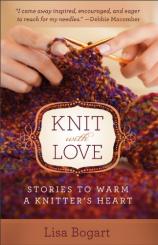Lisa Bogart has a job that any self-respecting knitter should envy: She works at a yarn store. That means on her workdays she's surrounded by beautiful natural fibers in exquisite textures and colors, as well as all of those tools and gadgets that knitters, crocheters, spinners and weavers simply have to have. That also means that she hears lots of personal stories from expert fiber artists and novice needleworkers alike. In KNIT WITH LOVE, she assembles those stories and shares her insights into the often unexpected benefits of expressing your creativity with some skeins of yarn and a set of knitting needles.
"Readers who work with yarn, whether they use needles or hooks or looms, should find a great deal of inspiration here, expressed through stories they likely can relate to."
Bogart begins her book with every knitting project's initial step: the "Cast On," also the title of the first chapter. The titles of subsequent chapters similarly use terms familiar to knitters: "Knit Two Together," for example, and "Continue in Established Pattern." Those titles reflect a spiritual concept that serves as inspiration for readers to discover valuable lessons in the work they do with their hands.
The chapter titled "Place a Marker," a compilation of some of the author's "aha!" moments, reads like a devotional, with a scripture verse introducing each entry. A verse about the birth of Christ preceded her account of knitting a baby sweater for Guideposts Knit for Kids, one of the many knitting-related charities she mentions in the book. In fact, she devotes an entire chapter to a description of various charities that knitters contribute their workmanship to, such as Operation Toasty Toes, through which knitters create warm slippers for men and women serving in the military.
One of the unusual delights of KNIT WITH LOVE is a chapter on the history of knitting, which even to avid knitters could be, well, boring. But Bogart uses the storytelling format that serves her so well in the rest of the book in this chapter as well, relating the accounts of individual knitters, mostly women, who provided much-needed socks and other hand-knit items to soldiers fighting in the Revolutionary War, the Civil War, and both world wars. She also brings in other knitters to provide personal stories of how the legacy of knitting impacted their lives.
Among the most touching stories is the one told by Staff Sergeant John Sorich IV, who had started crocheting hats as a snowboarder and began knitting when he worked in a juvenile correction center, where knitting helped calm the kids. When he was deployed to Iraq in 2009, he took his knitting along, eventually getting together a group of 10 regular knitters in his unit. Among their projects were exact replicas of World War II caps and gloves.
Among the other chapters are "Increase," which focuses on making knitted gifts as a form of outreach, and "Work in the Round," a knitting term used here to describe the joy of knitting in community. And while the bulk of the book is devoted to inspirational stories, KNIT WITH LOVE also provides lots of practical help for knitters, like some clever tips that even seasoned knitters may not be familiar with, advice on how to start a knitting group, and a selection of recommended books and websites for knitters.
Some parts of the book can be confusing, because it's not always clear whose story is being told. But that shouldn't be a significant problem; any knitter who can follow a multicolored, complex Fair Isle pattern faces far more confusion but manages to complete the project anyway. Readers who work with yarn, whether they use needles or hooks or looms, should find a great deal of inspiration here, expressed through stories they likely can relate to.





